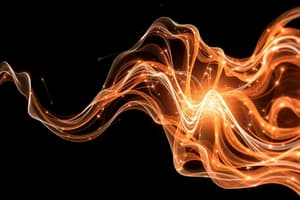Podcast
Questions and Answers
What is the correct formula for calculating kinetic energy?
What is the correct formula for calculating kinetic energy?
- $KE = 1/2 * mv^2$ (correct)
- $KE = 1/2 * mv$
- $KE = mv^2$
- $KE = 2 * mv^2$
Which type of energy is stored in the bonds of chemical compounds?
Which type of energy is stored in the bonds of chemical compounds?
- Chemical energy (correct)
- Mechanical energy
- Thermal energy
- Nuclear energy
Which statement accurately reflects the law of conservation of energy?
Which statement accurately reflects the law of conservation of energy?
- Energy can only be transformed from one form to another. (correct)
- Energy can be created and destroyed.
- Energy transformations always result in some energy being lost.
- Energy is always conserved in a closed system.
What describes a closed system?
What describes a closed system?
What defines efficiency in the context of energy systems?
What defines efficiency in the context of energy systems?
Which of the following is NOT a method of heat transfer?
Which of the following is NOT a method of heat transfer?
What is a primary environmental concern associated with fossil fuels?
What is a primary environmental concern associated with fossil fuels?
Which energy source is considered renewable?
Which energy source is considered renewable?
What is a significant drawback of nuclear energy?
What is a significant drawback of nuclear energy?
What is the goal of energy efficiency measures?
What is the goal of energy efficiency measures?
Flashcards
Energy
Energy
The ability to do work. Work is done when a force moves an object over a distance.
Kinetic Energy
Kinetic Energy
The energy an object possesses due to its motion.
Potential Energy
Potential Energy
The energy an object possesses due to its position or configuration.
Mechanical Energy
Mechanical Energy
Signup and view all the flashcards
Chemical Energy
Chemical Energy
Signup and view all the flashcards
Specific Heat Capacity
Specific Heat Capacity
Signup and view all the flashcards
Conduction
Conduction
Signup and view all the flashcards
Convection
Convection
Signup and view all the flashcards
Radiation
Radiation
Signup and view all the flashcards
Renewable Energy
Renewable Energy
Signup and view all the flashcards
Study Notes
Classical Mechanics and Energy
- Energy is the capacity to do work. Work is done when a force causes a displacement.
- The work-energy principle states that the net work done on an object is equal to the change in its kinetic energy.
- Kinetic energy (KE) is the energy of motion, calculated as KE = 1/2 * mv². Where 'm' is mass and 'v' is velocity.
- Potential energy (PE) is the energy an object possesses due to its position or configuration. Examples include gravitational potential energy and elastic potential energy.
- Gravitational potential energy (GPE) is calculated as GPE = mgh, where 'm' is mass, 'g' is acceleration due to gravity, and 'h' is height.
- Elastic potential energy is stored in objects that can be stretched or compressed, like a spring.
- The law of conservation of energy states that energy cannot be created or destroyed, only transformed from one form to another.
- Examples of energy transformations include a falling ball converting GPE to KE, or a burning fuel converting chemical energy to thermal energy.
Types of Energy
- Mechanical energy is the sum of kinetic and potential energy in a mechanical system.
- Thermal energy is the internal energy of a substance due to the kinetic energy of its particles.
- Chemical energy is stored in the bonds of chemical compounds and released during chemical reactions.
- Electrical energy is the energy carried by electric charges.
- Electromagnetic energy is energy that travels as waves, like light and radio waves.
- Nuclear energy is energy stored in the nucleus of an atom, and released in nuclear reactions like fission and fusion.
Energy and Systems
- A closed system is one that does not exchange matter with its surroundings, but energy can be transferred in or out.
- An isolated system is one that does not exchange either matter or energy with its surroundings.
- Power is the rate at which work is done or energy is transferred. Often measured in Watts (J/s).
- Efficiency describes the ratio of useful energy output to total energy input, usually expressed as a percentage.
Energy in Thermodynamics
- Thermodynamics deals with the relationships between heat, work, and other forms of energy.
- The first law of thermodynamics states that energy cannot be created or destroyed, only transferred or transformed.
- The second law of thermodynamics states that the total entropy of an isolated system can only increase over time. Entropy is a measure of disorder.
- The specific heat capacity of a substance is the amount of heat energy required to raise the temperature of one unit of mass by one degree Celsius.
- Heat transfer can occur through conduction, convection, and radiation.
- Conduction is heat transfer through direct contact.
- Convection is heat transfer through the movement of fluids.
- Radiation is heat transfer through electromagnetic waves.
Energy Resources
- Fossil fuels (coal, oil, natural gas) are a major source of energy, but they release greenhouse gases and are finite resources.
- Renewable energy sources (solar, wind, hydro, geothermal, biomass) are environmentally friendly and replenishable.
- Nuclear energy provides a large amount of power but involves safety concerns and radioactive waste disposal.
- Energy efficiency measures aim to reduce the amount of energy required to perform a task, thus reducing environmental impact and cost.
Studying That Suits You
Use AI to generate personalized quizzes and flashcards to suit your learning preferences.



